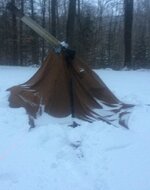Kevin Dill
WKR
- Joined
- Aug 26, 2014
- Messages
- 3,158
I find sleeping bag and boot ratings to be equally dependable. Boots that keep a friend's feet warm often leave me suffering. A bag or boots that keeps a majority warm at 10 degrees may still fail dreadfully for me or you. A good bit of it has to do with the quality and construction of the bag. When it could be single digits I'll be found in a Western Mountaineering Sequoia GWS (5 degree bag) on top of an Exped Downmat 9 with about 4" of inflated thickness and a high R-value.
Regardless of what type shelter you use, always bring a bag and pad that has proven able to keep you warm in the coldest temps you might experience. The wood stove is great accessory and tool to have along on extended trips, It's honestly a poor substitute for the right bedroll. I use my stove in equal measure to dry out clothes, boots and tipi interior, and for plain old luxury comfort when I'm tired and chilled. I love being in my camp bed listening to the crackle and snap of a fire nearby....a bit of orange glow lulling me to sleep.
Regardless of what type shelter you use, always bring a bag and pad that has proven able to keep you warm in the coldest temps you might experience. The wood stove is great accessory and tool to have along on extended trips, It's honestly a poor substitute for the right bedroll. I use my stove in equal measure to dry out clothes, boots and tipi interior, and for plain old luxury comfort when I'm tired and chilled. I love being in my camp bed listening to the crackle and snap of a fire nearby....a bit of orange glow lulling me to sleep.

